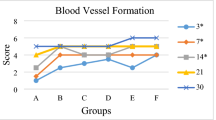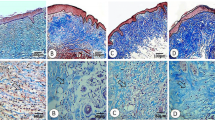Abstract
Hyperglycemia is a unique characteristic that initiates the pathogenesis of diabetic complications and causes the delay observed in healing of diabetic wound. Sphenocentrum jollyanum, a flowering part of the Menispermaceae family, plays important roles in ethno-medicine and is reputed in folklore as an antihyperglycemic agent and in chronic wound dressing.
This study evaluates the effect of Sphenocentrum jollyanum root and leaf extracts on glycemic state and wound closure in a type 2 diabetic rat induced by high fat diet and streptozotocin (STZ). The experimental animals were fed high fat diet for 14 days, and low dose (35 mg/kg) of streptozotocin (STZ) was afterwards administered intraperitoneally. The blood glucose of the animals were measured after 72 h of STZ administration and wound subsequently created. The rats were given S. jollyanum extracts (100 and 200 mg/kg b.w) through oral gavage and also administered topically on the wound area for two weeks. An increased level of glucose, glycated hemoglobin, and lipids, as well as activities of α-amylase, α-glucosidase, and lipase observed in diabetic rats was reduced significantly (P < 0.05) after treatment with S. jollyanum extracts. Furthermore, wound contraction rate was faster with administration of the root extract in comparison to the diabetic control. Maintaining a steady glycemic state is essential in diabetic wound repair, and the findings from this research suggest that S. jollyanum may represent a source of phytochemicals for the treatment of diabetic wound.









Similar content being viewed by others
References
Adefegha SA, Oboh G (2012) Inhibition of key enzymes linked to type-2 diabetes and sodium nitroprusside-induced lipid peroxidation in rat pancreas by water extractable phytochemicals from some tropical spices. Pharm Biol 50(7):857–865
Adefegha SA, Oboh G, Adefegha OM et al (2014) Antihyperglycemic, hypolipidemic, hepatoprotective and antioxidative effects of dietary clove (Szyzgium aromaticum) bud powder in a high-fat diet/streptozotocin-induced diabetes rat model. J Sci Food Agric 94:2726–2737
Adefegha SA, Oboh G, Adefegha OM (2017) Ashanti pepper attenuates carbohydrate hydrolyzing, blood pressure regulating and cholinergic enzymes in experimental type 2 diabetes rat model. J Basic Clin Pharma Physiol 28(1):19–30
Ademiluyi AO, Oboh G (2013) Soybean phenolic rich extracts inhibits key-enzymes linked to diabetes (α-amylase and α-glucosidase) and hypertension (angiotensin-I-converting enzyme ACE) in vitro. Exp Toxicol Pathol 65(3):305–309
Alavi A, Sibbald RG, Mayer D et al (2014) Diabetic foot ulcers: part I. Pathophysiology and prevention. J Am Acad Dermatol 70 (1):1–18
Ali H, Houghton PJ, Soumyanath A (2006) Alpha amylase inhibitory activity of some Malaysian plants used to treat diabetes; with particular reference to Phyllanthus amarus. J Ethnopharmacology 107:449–455
Apostolidis E, Kwon YI, Shetty K (2007) Inhibitory potential of herb, fruit, and fungal-enriched cheese against key enzymes linked to type 2 diabetes and hypertension. Inn Food Sci Emer TechnoloGy 8:46–54
Ardeshirlarijani E, Namazi N, Jalili RB et al (2019) Potential anti-obesity effects of some medicinal herb: in vitro α-amylase, α-glucosidase and lipase inhibitory activity. Int Biol Biomed Journal 5(2):1–8
Awasthi A, Parween N, Singh VK, Anwar A, Prasad B, Kumar J (2016) Diabetes: symptoms, cause and potential natural therapeutic methods. Adv Diabet Metab 4(1):10–23
Blakely M (2016) The use of best practice in the treatment of a complex diabetic foot ulcer: a case report. Healthcare (basel) 4:18
Blakytny R, Jude E (2006) The molecular biology of chronic wounds and delayed healing in diabetes. Diabet Med 23:594–608
Chipiti T, Ibrahim MA, Singh M, Islam S (2015) In vitro α-amylase and α-glucosidase inhibitory effects and cytotoxic activity of Albizia antunesiana extracts. Pharmacogn Mag 11(2):S231–S236
Farhood HB, Al-salih RM, Radhi MN (2014) Clinical studies to evaluate pancreatic functions in the patients of type 2 diabetes mellitus. IJIAS 7(1):413–420
Forsythe RO, Brownrigg J, Hinchliffe RJ (2015) Peripheral arterial disease and revascularization of the diabetic foot. Diabetes Obes Metab 17:435–444
Gianino E, Miller C, Gilmore J (2018) Smart wound dressings for diabetic chronic Wounds. Bioengineering 5:51
Ilodigwe EE, Akah PA (2009) An experimental evaluation of the analgesic and anti-inflammatory properties of a traditional remedy. Asian J Med Sci 1:35–38
International Diabetes Federation (2017) IDF diabetes atlas, 8th edn. Brussels, Belgium
Jeyabalan S, Palayan M (2009) Antihyperlipidemic activity of Sapindusemarginatus in Triton WR-1339 induced albino rats. Res J Pharm Technology 2(2):319–323
Lucia MP, Cintia MR, Mario DB, Guillermo RC (2006) Catalytic properties of lipase extracts from Aspergillus niger. Food Technol Biotechnol 44:247–252
Mbaka GO, Adeyemi OO, Osinubi A, Noronha CC, Okanlawon OA (2009) The effect of aqueous root extract of Sphenocentrum jollyanum on blood glucose level of rabbits. J Medicin Plants Res 3(11):870–874
Mbaka GO, Adeyemi OO, Ogbonnia SO et al (2011) The protective effect of ethanol root extract of Sphenocentrum jollyanum on the morphology of pancreatic beta cells of alloxan challenged rabbits. J Morphol Sci 28:37–45
McCue P, Kwon YI, Shetty K (2005) Anti-diabetic and anti-hypertensive potential of sprouted and solid-state bioprocessed soybean. Asian Pac J Clin Nutrition 14:145–152
Mercocci L, Marguire JJ, Droy-Lefaiz MT, Parker L (1994) The nitric oxide scavenging properties of Ginkgo biloba extract EGB 761. Biochem Biophys Res Comm 201:748–755
Mishra PR, Panda PK, Apanna KC, Panigrahi S (2011) Evaluation of acute hypolipidemic activity of different plant extracts in Triton WR-1339 induced hyperlipidemia in albino rats. Pharmacol Online 3:925–934
Nair SS, Kavrekar V, Mishra A (2013) In vitro studies on α-amylase and α glucosidase inhibitory activities of selected plant extracts. Eu J Exp Biol 3(1):128–132
Oboh G, Akinyemi JA, Ademiluyi AO, Adefegha SA (2010) Inhibitory effect of aqueous extract of two varieties of Ginger on key enzymes linked with type-2 diabetes. J Food Nutri Res 49(1):14–20
Oboh G, Ademosun AO, Akinleye M, Omojokun OS, Boligon AA, Athayde ML (2015) Starch composition, glycemic indices, phenolic constituents, and antioxidative and antidiabetic properties of some common tropical fruits. J Ethnic Foods 2:64–73
Olorunnisola OS, Afolayan AJ (2011) In vivo anti-malaria activity of leaf and root extracts of S. jollyanum pierre. Afr J Pharm Pharmacol 5(14):1669–1673
Ozougwu JC, Obimba KC, Belonwu CD, Unakalamba CB (2013) The pathogenesis and pathophysiology of type 1 and type 2 diabetes mellitus. J Physiol Pathophysiol 44:46–57
Pengzi Z, Jing L, Yali J, Sunyinyan T, Dalong Z, Yan B (2017) Global epidemiology of diabetic foot ulceration: a systematic review and meta-analysis. Ann Med 49:106–116
Petrie JR, Guzik TJ, Touyz RM (2018) Diabetes, hypertension, and cardiovascular disease: clinical insights and vascular mechanisms. Can J Cardiol 34:575–584
Raghav A, Khan ZA, Labala RK, Ahmad J, Noor S, Mishra BK (2018) Financial burden of diabetic foot ulcers to world: a progressive topic to discuss always. Therap Adv Endocrin Metab 9(1):29–31
Singh A, Bajpai S, Singh N, Kumar V, Gour JK, Singh PK, Singh RK (2014) Wound healing activity of standardized extract of Curculigo orchioides in streptozotocin–induced diabetic mice. Asian Pac J Trop Dis 4:S48–S53
Sridhar SN, Mutya S, Paul AT (2017) Bis-indole alkaloids from Tabernaemontana divaricata as potent pancreatic lipase inhibitors: molecular modelling studies and experimental validation. Med Chem Research 26:1268–1278
Srinivasan K, Viswanad B, Asrat L, Kaul CL, Ramarao P (2005) Combination of high fat diet-fed and low-dose streptozotocin-treated rat: a model for type 2 diabetes and pharmacological screening. Pharmacol Res 52:313–320
Tesfaye S, Boulton AJ, Dyck PJ, Freeman R, Horowitz M, Kempler, P.… Jones, T. (2010) Diabetic neuropathies: update on definitions, diagnostic criteria, estimation of severity, and treatments. Diabetes Care 33(10):2285–2293
Tundis R et al (2010) Natural products as alpha-amylase and alpha-glucosidase inhibitors and their hypoglycemic potential in the treatment of diabetes: an update. Mini-Rev Med Chem 10:315–331
Vistoli G, De Maddis D, Cipak A, Zarkovic N, Carini M, Aldini G (2013) Advanced glycoxidation and lipoxidation end products (ages and ales): an overview of their mechanisms of formation. Free Radic Res 47(1):3–27
Worthington Biochemical Corp (2001) Worthington enzyme and related biochemicals. Worthington Biochemical Corporation, Freehold, NJ
Acknowledgements
The authors deeply acknowledge the laboratory assistants for their effort in making the work a success.
Author information
Authors and Affiliations
Corresponding author
Ethics declarations
Ethical approval
The experimental animals were properly handled according to the National Institute of Health guide, and the protocols used for the animal study were approved by the FUTA Committee for ethical use of research animals, Centre for Research and Development, Federal University of Technology Akure, Nigeria.
Informed consent
None
Conflict of interest
The authors declare no competing interests.
Additional information
Publisher's Note
Springer Nature remains neutral with regard to jurisdictional claims in published maps and institutional affiliations.
Rights and permissions
About this article
Cite this article
Adeleke, O.V., Adefegha, S.A. & Oboh, G. Sphenocentrum jollyanum root and leaf extracts enhanced wound closure by improving the glycemic state of diabetic rats induced by high-fat diet/streptozotocin. Comp Clin Pathol 30, 881–889 (2021). https://doi.org/10.1007/s00580-021-03279-0
Received:
Accepted:
Published:
Issue Date:
DOI: https://doi.org/10.1007/s00580-021-03279-0




